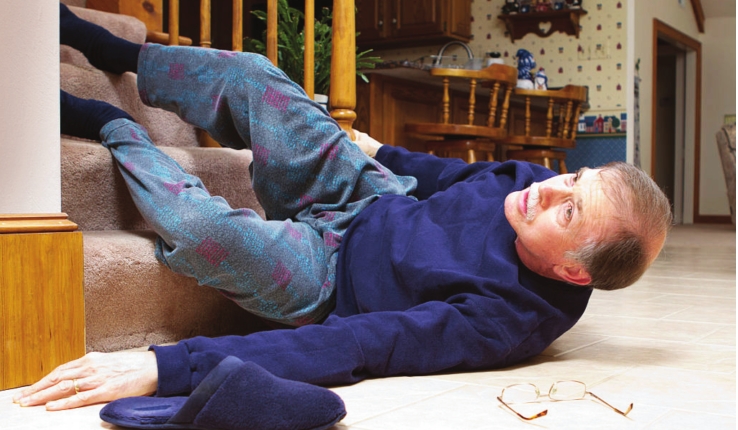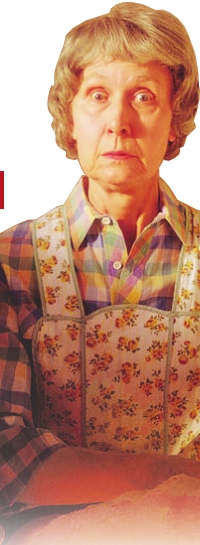PREVENTING FALLS IN YOUR HOME

Simple tips to help ensure your safety
When you look around your home, what do you see?
You may see the scratched dining room table your family gathered around at mealtime, the mantelpiece in your living room where stockings were hung with care, or the vase that was a wedding gift many years ago.
As you look around, the memories pour out from every nook and cranny. But what you may not notice as you look around your home are fall hazards.
Each year, according to the National Safety Council, one in every three adults age 65 and older will fall. The Centers for Disease Control and Prevention has determined falls are the leading cause of fatal and nonfatal injuries for the same age group.
Fall hazards may be lurking around the home. For example, the family room rug that keeps bunching up or the light bulb that is out in the hallway may seem like small annoyances, but they can quickly turn into fall hazards. Take some time to look around the house and analyze all of the potential fall risks.
Make sure furniture throughout the home is arranged so one can easily enter, navigate or exit a room. Remove any clutter or trip hazards such as old magazines, electrical cords, pet toys and extra furniture to ensure all pathways are clear. Do you have a difficult time getting up from your sofa, chair or favorite recliner? Seating height is an important consideration for your safety and having the correct height furniture can make it easier to transfer and prevent a fall.
Replace burned-out light bulbs and consider increased lighting for better visibility throughout your home. Install night-lights in bathrooms, bedrooms and hallways for easier navigation at night.
The placement of the bed in the bedroom is also important to ensure one’s safety. Any obstacles such as unneeded furniture, a pet bed, television set, plants or magazines are all trip hazards and should be removed from the path between the bed and the bathroom.
Move the nightstand or side table close within reach of the bed and place a lamp on it that will provide bright light. The telephone should be within close reach of your bed, too.
To prevent difficulty getting into and out of bed, consider selecting a new mattress. For a quick and easy solution, purchase a grab bar that will slide between the mattress and box spring. These are available at most home improvement or medical supply stores.
More slips and falls happen in the bathroom than any other room in the house. Use non-skid mats next to the bath tub or shower and remove them from the floor when not bathing or showering. Use a nonslip rubber mat or install non-skid adhesive strips on the floor of your tub or shower. The installation of grab bars, a shower bench and hand-held shower head can help reduce the risk of falling while bathing.
Elevate the toilet seat and install grab bars on either side allowing for ease in getting up and down. A bedside toilet placed over your existing toilet can also be used for ease in transferring. Consider replacing your glass tub/shower enclosure with a shower curtain allowing for a wider and easier entrance.
Making sure dishes, glassware and cookware are within easy reach in the kitchen may sound simple, but this small change can prevent falls. Consider moving items you use daily such as coffee supplies and condiments to lower shelves or leave them out on the countertop for easy access.
Although area rugs and runners can make a home feel cozier, one needs to consider removing any area rugs or runners that you encounter daily to prevent falls. To keep them in place, use a non-slip backing tape or pads to ensure they are securely attached to the floor so that they will not bunch up or slip.
Hallways and stairways are often overlooked for fall hazards. Make sure all hallways and stairways are well-lighted and clear from shoes, cords and other objects that could cause a tripping hazard. Have any loose, uneven or broken stairs, loose carpeting or runners on your stairs repaired or reattached immediately. The installation of hand rails on both sides of a stairway will help you ambulate with more stability.
These few tips are just a starting point to fall prevention. In addition to the home environment, many falls can be prevented by making simple personal and lifestyle changes. These adjustments include simply slowing one’s pace of movement and paying closer attention to how the feet and legs react to what your brain is thinking.
Older adults with arthritis, osteoporosis and blood pressure fluctuation are more prone to falls as well as those who suffer from neurological conditions such as Parkinson’s disease or Alzheimer’s disease. Ask the doctor to assess fall risk and suggest changes in medications or lifestyle that can reduce the risk of falling.
Scott H. Green is a Certified Senior Advisor® and president of Preferred Care at Home. Green can be reached via e-mail at scottg@preferhome.com.
CHECKLIST FOR FALL PREVENTION
Area Rugs
Proper Lighting
Furniture Placement
Bathroom Aids
